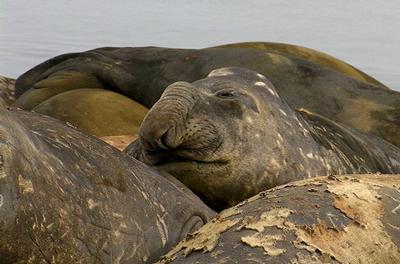
|
|
4 March, 2001
Davis Wildlife
Up to this point wildlife was always something viewed from the boat, not
something up close and personal. What a treat to be able to view the animals
at my leisure because the ship is not moving at 8 knots.
The elephant seals lined the small beach in front of the Davis station
waiting out their annual molt. The small blood vessels in their skin, called
capillaries, are engorged with blood then separated or shunted from the
heated blood below. This causes their outer skin to die and slough off.
Huddled together for warmth they look moth-eaten and very uncomfortable.
Every so often one of them would change position causing a ruckus within the
group. Sometimes the disagreements became minor altercations with males
challenging each other. Many of the males had scars from previous fights,
most likely from their breeding season. Males fight over territory on
beaches where the females come to breed. Only the strongest last through the
challenges leaving only one to breed with his harem. The haremless males
wait out the season on other beaches. The large nose on the males can be
inflated, which then becomes a loud sounding chamber for the males' roaring
calls.
The southern elephant seal (Mirounga leonina Linnaeus) is the world's
largest seal with males reaching up to 11,000 pounds (5000kg). As I was
standing near them being careful not to get too close, I noticed that, even
lying down, they were nearly as tall as me. The males can reach lengths of
13 to 17 feet (4-5 meters). Females are quite a bit smaller weighing around
1800 pounds (800 kg) and getting up to 7-10 feet (2-3 meters) in length. The
pups grow incredibly fast on milk that is 50% fat. Twenty -two days after
birth they are ready to be weaned but not without quadrupling their weight.
From there they change to a diet of squid caught in the deep ocean waters.
They can dive up to two kilometers under the water. To get so deep; the
seals have the ability to lower their heart rate to as little as one beat
per minute. Because of this they can stay under the water up to two hours!
What's more amazing is that they come to the surface for only a few minutes
before they dive again.





Contact the TEA in the field at
.
If you cannot connect through your browser, copy the
TEA's e-mail address in the "To:" line of
your favorite e-mail package.
|
